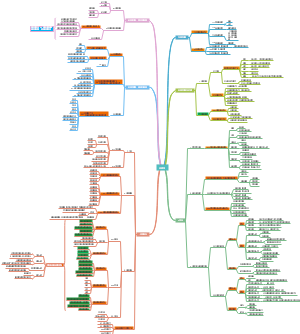导图社区 Chapter5_Foundations of Planning
- 18
- 0
- 0
- 举报
Chapter5_Foundations of Planning
Defining the organizational purpose and ways to achieve it. Planning includes defining goals, establishing strategy, and developing plans to coordinate activities.
编辑于2022-12-12 13:16:26 四川省- Chapter6_Organizational Structure and Design
Chain of CommandThe line of authority extending from upper organizational levels to lower levels, which clarifies who reports to whom.
- Chapter5_Foundations of Planning
Defining the organizational purpose and ways to achieve it. Planning includes defining goals, establishing strategy, and developing plans to coordinate activities.
- Chapter4_Foundations of Decision Making
Intuitive decision making can complement both bounded rationality and rational decision making.
Chapter5_Foundations of Planning
社区模板帮助中心,点此进入>>
- Chapter6_Organizational Structure and Design
Chain of CommandThe line of authority extending from upper organizational levels to lower levels, which clarifies who reports to whom.
- Chapter5_Foundations of Planning
Defining the organizational purpose and ways to achieve it. Planning includes defining goals, establishing strategy, and developing plans to coordinate activities.
- Chapter4_Foundations of Decision Making
Intuitive decision making can complement both bounded rationality and rational decision making.
- 相似推荐
- 大纲
Chapter5 Foundations of Planning
What is planning?
Defining the organizational purpose and ways to achieve it. Planning includes defining goals, establishing strategy, and developing plans to coordinate activities.
Planning is often called the primary management function because it establishes the basis for all the other things managers do
It’s concerned with ends (what is to be done) as well as with means (how it’s to be done)
Why do managers need to plan?
Managers should plan for at least four reasons
establishes coordinated effort
reduces uncertainty
reduces overlapping and wasteful activities
establishes the goals or standards that facilitate control
What Do Managers Need to Know About Strategic Management?
Strategic Management What managers do to develop an organization’s strategies
Strategies Plans for how the organization will do what it’s in business to do, how it will compete successfully, and how it will attract its customers in order to achieve its goals
Strategic Management Process A six-step process that encompasses strategy planning, implementation, and evaluation
Identifying the organization’s current mission, goals and strategies
Mission A statement of an organization’s purpose
Doing an external analysis
Opportunities Positive trends in the external environment
Threats Negative trends in the external environment
Doing an internal analysis
Strengths Any activities the organization does well or any unique resources that it has
Weaknesses Activities the organization doesn’t do well or resources it needs but doesn’t possess
(Capabilities) An organization’s skills and abilities in doing the work activities needed in its business (Core Competencies) The major value-creating capabilities of an organization
SWOT Analysis
Formulating the strategies
Implementing strategies
Evaluating results
Types of Strategies
Corporate Strategy An organizational strategy that specifies what businesses a company is in or wants to be in and what it wants to do with those businesses The three main types of corporate strategies are growth, stability, and renewal
Growth Strategy A corporate strategy in which an organization expands the number of markets served or products offered either through its current business(es) or through new business(es).
Concentration Focuses on its primary line of business and increases the number of products offered.
Vertical Integration Backward (supplier, input) or forward (distributor, output) vertical integration
Horizontal Integration Grows by combining competitors
Diversification Grow through combination with related or unrelated industries.
Stability Strategy A corporate strategy in which an organization continues to do what it is currently doing
Renewal Strategy A corporate strategy that addresses declining organizational performance
Competitive Strategy An organizational strategy for how an organization will compete in its business(es)
Cost Leadership Strategy Competing on the basis of having the lowest costs in the industry
Differentiation Strategy Competing on the basis of having unique products that are widely valued by customers
Focus Strategy Competing in a narrow segment or niche with either a cost focus or a differentiation focus
Functional Strategy The strategies used in an organization’s various functional departments to support the competitive strategy
How Do Managers Set Goals and Develop Plans?
Planning involves two important aspects: goals and plans. Planning = goals+ plans
Goals (objectives) Desired outcomes or targets
Stated Goals Official statements of what an organization says, and wants its stakeholders to believe, its goals are
Real Goals Those goals an organization actually pursues as shown by what the organization’s members are doing
Traditional Goal Setting Goals set by top managers flow down through the organization and become sub-goals for each organizational area
Goal Setting
Means-End Chain An integrated network of goals in which higher level goals (ends) are linked to lower-level goals, which serve as the means for their accomplishment
Management By Objectives (MBO) A process of setting mutually agreed-upon goals and using those goals to evaluate employee performance
Plans Documents that outline how goals are going to be met. They usually include resource allocations, budgets, schedules, and other necessary actions to accomplish the goals
TYPES OF PLANS
Breadth
Strategic Plans Plans that apply to the entire organization and encompass the organization’s overall goals
Tactical Plans Plans that specify the details of how the overall goals are to be achieved
Time Frame
Long-term Plans Plans with a time frame beyond three years
Short-term Plans Plans with a time frame of one year or less
Specificity
Specific Plans Plans that are clearly defined and leave no room for interpretation
Directional Plans Plans that are flexible and set general guidelines
Frequency of Use
Single-use Plan A one-time plan specifically designed to meet the needs of a unique situation
Standing Plans Plans that are ongoing and provide guidance for activities performed repeatedly









